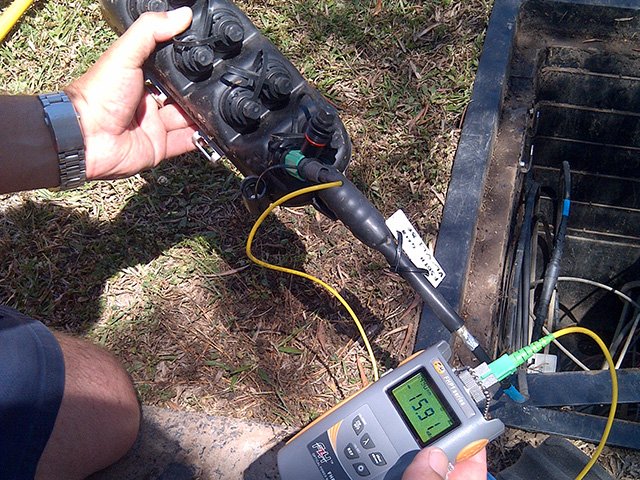The use of ofda enhances fibre evaluation with advanced optical technology.
The use of ofda enhances fibre evaluation with advanced optical technology.
Blog Article
The Duty of Optical Fiber Screening in Ensuring Quality and Performance in Connectivity Solutions
In today's quickly evolving digital landscape, the value of optical fiber testing can not be overemphasized, as it serves as a keystone for ensuring the quality and performance of connectivity solutions. As modern technology proceeds to development, the future of optical fibre screening postures appealing difficulties and possibilities that warrant closer assessment.
Relevance of Optical Fibre Screening
The value of optical fibre screening can not be overemphasized in making sure the honesty and performance of communication networks. As the backbone of modern telecoms, optical fibres promote high-speed information transmission, making their reliability vital to functional success. Checking serves as a positive step to determine possible concerns such as signal loss, depletion, and physical damages, which can compromise network performance.
Regular testing enables the verification of setup quality and the discovery of defects that could affect data stability - optical fibre diameter analyser. By employing extensive screening methods, network operators can minimize the threats related to network failures, consisting of downtime and economic losses. Optical fibre screening guarantees conformity with industry standards and regulations, enhancing the overall high quality of service offered to end-users.
Ultimately, the organized analysis of optical fibres contributes to the long life and efficiency of communication systems. It allows stakeholders to make informed choices regarding upkeep, upgrades, and troubleshooting. In a landscape where data is progressively crucial, focusing on optical fibre testing is important to sustaining robust and effective connection solutions, thus supporting the demands of contemporary digital settings.
Kinds Of Optical Fibre Examinations
Various testing methods are utilized to make sure the functionality and integrity of optical fibers within interaction networks. These tests can be broadly classified into two major kinds: setup examinations and maintenance examinations.
Installment tests are carried out instantly after the setup of optical fiber cables to verify their performance and honesty - fibre testing equipment. The most common installation tests consist of Optical Time-Domain Reflectometry (OTDR) examinations, which examine the high quality of the fibre by recognizing mistakes or breaks, and end-to-end loss tests, which determine the overall optical loss from one end of the fibre to the other
Upkeep tests, on the various other hand, are performed periodically to guarantee recurring efficiency and find prospective concerns with time. These consist of aesthetic inspection, which look for physical damages or incorrect setups, and connection tests, which verify that the signal can go through the fiber without disruption.
Furthermore, progressed examinations such as Polarization Setting Diffusion (PMD) and Chromatic Dispersion (CD) tests can be conducted to review the fiber's performance under different problems. By utilizing these diverse testing methods, specialists can preserve high standards of high quality and reliability in optical fibre networks.
Benefits of Normal Evaluating
Regular screening of optical fibers plays an essential role in keeping the general efficiency and dependability of communication networks. By carrying out regular evaluations, organizations can ensure that their fiber optic installations meet sector requirements and operate successfully. This proactive method helps to identify potential weak points and destruction with time, enabling timely interventions prior to concerns rise.

Cost-effectiveness is an additional benefit. By resolving small problems early, companies can stay clear of the high expenses connected with significant repairs or system failures. Routine screening also fosters compliance with regulatory needs, guaranteeing that the network sticks to essential safety and efficiency requirements.
Typical Concerns Determined
Identifying usual problems in optical fibre networks is crucial for preserving ideal efficiency and integrity. Various variables can add to interruptions, including physical damages, poor installment practices, and environmental influences.
Physical damages, such as bends, breaks, or abrasions, can significantly break down signal high quality. Improper installment techniques, including excessive stress or poor protecting of cables, may lead to increased depletion and loss of connectivity. Furthermore, environmental factors such as temperature level changes, wetness ingress, and rodent interference can endanger the honesty of the fibre.
Adapter issues additionally often emerge, with inappropriate placement or contamination resulting in enhanced insertion loss. Additionally, splicing errors can introduce significant signal deterioration if not performed with accuracy.

Attending to these common issues with normal optical fibre testing not just boosts more helpful hints network dependability but likewise maximizes overall efficiency, making certain that connection remedies stay durable and effective.
Future Fads in Checking
As the demand for high-speed connectivity continues to rise, the future of optical fibre testing will progressively concentrate on automation news and advanced analytics. The integration of expert system (AI) and artificial intelligence (ML) in testing processes will certainly make it possible for a lot more effective data analysis and anticipating upkeep, minimizing downtime and improving total network reliability. Automated screening solutions will certainly streamline the examination and accreditation of fibre networks, minimizing human mistake and raising screening throughput.
One more substantial trend is the fostering of remote screening innovations. As the implementation of fibre networks increases into remote and underserved areas, remote screening capacities will enable service technicians to check and identify network problems without physical visibility, consequently lowering functional expenses and improving action times.
Furthermore, there will certainly be a shift towards more detailed testing requirements that incorporate not only conventional loss measurements however likewise efficiency metrics such as latency and transmission capacity application. This all natural approach will assist in better network management and optimization techniques.
As these patterns advance, the optical fibre screening landscape will not only boost the high quality and effectiveness of connectivity solutions however likewise sustain the expanding complexities of modern communication networks.
Verdict
In conclusion, optical fibre testing serves as an essential component in preserving the integrity visit site and effectiveness of communication networks. The continuous dedication to normal testing not just boosts data transmission however likewise aligns with sector standards, cultivating reliability in network infrastructures.
Report this page